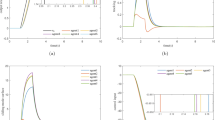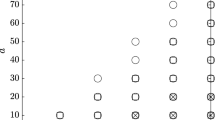Abstract
In this paper, new methods have been utilized to design and implement PD like fuzzy controllers for naval postgraduate school autonomous underwater vehicle. One of the main challenges for appropriate performance in the fuzzy controllers is to determine the optimal place for the membership functions for each inputs and outputs. Owing to the time variable dynamics, experimental knowledge or offline tuning with dynamic model cannot solve this problem correctly. The proposed method used \({H_\infty }\) robust filter with optimized covariance matrices for optimization of the membership functions of the designed controllers for heading and depth channels for the first time. Advantages of new investigated method are great convergence velocity and robustness against uncertainties of model and surrounding environment. In simulation results, the proposed method has been compared with extended Kalman filter (EKF), as another optimization approach. Results demonstrate that proposed method has impressive effects on tracking the desired path with dramatical decline in control efforts, which have crucial role in reducing energy consumption in practice, whereas the EKF simply leave its optimality when applying the real world conditions. Also, practical way for implementing designed controllers, multivariable regression analysis has been used. Statistical survey shows, fuzzy controllers can be easily substituted with obtained multivariable polynomials to be implemented in typical microcontrollers or other non-fuzzy hardware. As regarding to stability, passivity approach has been used to proof asymptotic stability of new designed controllers.






















Similar content being viewed by others
Abbreviations
- AUV:
-
Autonomous underwater vehicle
- NPS:
-
Naval postgraduate school
- TSK:
-
Takagi–Sugeno–Kang
- EKF:
-
Extended Kalman filter
- GA:
-
Genetic algorithm
- SISO:
-
Single input–single output
- SFC:
-
Sectorial fuzzy controller
- PID:
-
Proportional–integral–derivative
- PD:
-
Proportional–derivative
- SSE:
-
Sum of squared error
- RMSE:
-
Root-mean-square error
References
Kim J, Joe H, Yu S (2016) Time-delay controller design for position control of autonomous underwater vehicle under disturbances. IEEE Trans Ind Electron 63:1052–1061
Fischer N, Hughes D (2014) Nonlinear RISE-based control of an autonomous underwater vehicle. IEEE Trans Rob 30:845–852
Li H, Xie P (2017) Receding horizon formation tracking control of constrained underactuated autonomous underwater vehicles. W. IEEE Trans Ind Electron 64:5004–5013
Shaque KL, Abdullah SS, Ayob AM (2010) Single input fuzzy logic controller for unmanned underwater vehicle. J Intell Robot Syst 10:87–100
Kato N, Lto Y, Kojima J (1994) Control performance of autonomous underwater vehicle ‘AQUA Explorer 1000’ for inspection of underwater cables. In: Proceedings of OCEANS ’94, Oceans Engineering for Today’s Technology and Tomorrow’s Preservation, Brest, France, pp 135–140
Debitetto P (2002) Fuzzy logic for depth control of unmanned undersea vehicles. IEEE J Ocean Eng 20:242–248
Baoquan L, Keqiang H (1997) The nonlinear control using fuzzy logic for spinning underwater vehicle. In: IEEE international conference on intelligent processing systems, Beijing, China, pp. 223–226
Teo K (2012) A robust fuzzy autonomous underwater vehicle (AUV) docking approach for unknown current disturbances. IEEE J Ocean Eng 37:143–155
Shaque KL, Abdullah SS (2011) A simplified approaches to design fuzzy logic controller for underwater vehicle. Ocean Eng 38:271–284
Marvian Mashhad A, Mousavi Mashhadi SK (2013) PID like fuzzy logic control of an unmanned underwater vehicle. In: Proceedings of the 13th Iranian conference of fuzzy systems (IFSC), Qazvin, Iran
Figueiredo M, Gomide F (1999) Design of fuzzy systems using neuro-fuzzy networks. IEEE Trans Neural Netw 10:815–827
K.Tanakitkorn P, Wilson SR, Turnock, Philips AB (2017) Depth control for an over-actuated, hover-capable autonomous underwater vehicle with experimental verification. Mechatronics 41:67–81
Healey AJ, Good M (1992) The NPS AUV II autonomous underwater vehicle test bed: design and experimental verification. Nav Eng J 104:112
Healey AJ, Lienard D (1993) Multivariable sliding mode control for autonomous diving and steering of unmanned underwater vehicles. IEEE J Ocean Eng 18:327–338
Fossen T (1994) Guidance and control of ocean vehicles. Wiley, New York
Qiao L, Zhang W (2017) Adaptive non-singular integral terminal sliding mode tracking control for autonomous underwater vehicles. IET Control Theory Appl 11:1293–1306
Simon D (2006) Optimal state estimation. Wiley, New Jersey
Calcev G (1998) Some remarks on the stability of mamdani fuzzy control systems. IEEE Trans Fuzzy Syst 6:436–442
Hill D (1992) Dissipative nonlinear systems: basic properties and stability analysis. In: Proceedings of the 31st IEEE conference on desision control, Tucson, AZ, USA, pp 3259–3264
Ortega R (1995) On passivity based output feedback global stabilization of Euler–Lagrange systems. Int J Robust Nonlinear Control 15:381–386
Author information
Authors and Affiliations
Corresponding author
Additional information
This paper was recommended for publication in revised form by Associate Editor 000 000.
About this article
Cite this article
Marvian Mashhad, A., Mousavi Mashhadi, Sed. PD like fuzzy logic control of an autonomous underwater vehicle with the purpose of energy saving using \({H_\infty }\) robust filter and its optimized covariance matrices. J Mar Sci Technol 23, 937–949 (2018). https://doi.org/10.1007/s00773-017-0522-2
Received:
Accepted:
Published:
Issue Date:
DOI: https://doi.org/10.1007/s00773-017-0522-2




